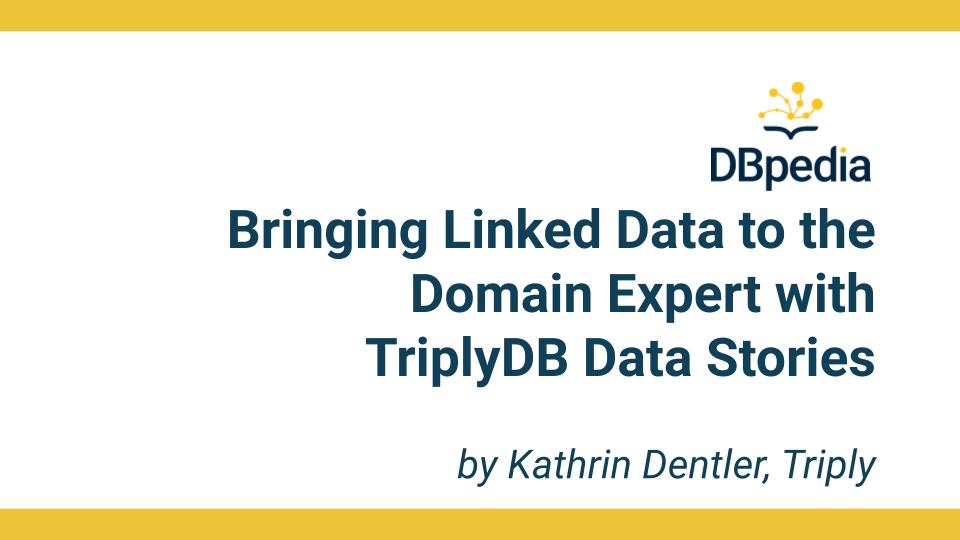DBpedia Member Features – Over the last year we gave DBpedia members multiple chances to present their work, tools and applications. In this way, our members gave exclusive insights on the DBpedia blog. This time we will continue with Triply, a Dutch company. They will introduce TriplyDB and data stories to us. Have fun reading!
by Kathrin Dentler, Triply
Triply and TriplyDB
Triply is an Amsterdam-based company with the mission to (help you to) make linked data the new normal. Every day, we work towards making every step around working with linked data easier, such as converting and publishing it, integrating, querying, exploring and visualising it, and finally sharing and (re-)using it. We believe in the benefits of FAIR (findable, accessible, interoperable and reusable) data and open standards. Our product, TriplyDB, is a user-friendly, performant and stable platform, designed for potentially very large linked data knowledge graphs in practical and large-scale production-ready applications. TriplyDB not only allows you to store and manage your data, but also provides data stories, a great tool for storytelling.
Data stories
Data stories are data-driven stories, such as articles, business reports or scientific papers, that incorporate live, interactive visualizations of the underlying data. They are written in markdown, and can be underpinned by an orchestration of powerful visualizations of SPARQL query results. These visualizations can be charts, maps, galleries or timelines, and they always reflect the current state of your data. That data is just one click away: A query in a data story can be tested or even tweaked by its readers. It is possible to verify, reproduce and analyze the results and therefore the narrative, and to download the results or the entire dataset. This makes a data story truly FAIR, understandable, and trustworthy. We believe that a good data story can be worth more than a million words.
Examples
With a data story, the domain expert is in control and empowered to work with, analyze, and share his or her data as well as interesting research results. There are some great examples that you can check out straight away:
- The fantastic data story on the Spanish Flu, which has been created by history and digital humanities researchers, who usually use R and share their results in scientific papers.
- Students successfully published data stories in the scope of a course of only 10 weeks.
- The beautiful data story on the Florentine Catasto of 1427.
DBpedia on triplydb.com
Triplydb.com is our public instance of TriplyDB, where we host many valuable datasets, which currently consist of nearly 100 billion triples. One of our most interesting and frequently used datasets are those by the DBpedia Association:
- a version from 2017 with 369.205.380 statements
- the DBpedia Snapshot 2021-06 Release with 845.807.279 statements, and
- a version of the DBpedia ontology
We also have several interesting saved queries based on these datasets.
A data story about DBpedia
To showcase the value of DBpedia and data stories to our users, we published a data story about DBpedia. This data story includes comprehensible and interactive visualizations, such as a timeline and a tree hierarchy, all of which are powered by live SPARQL queries against the DBpedia dataset.
Let us have a look at the car timeline: DBpedia contains a large amount of content regarding car manufacturers and their products. Based on that data, we constructed a timeline which shows the evolution within the car industry.
If you navigate from the data story to the query, you can analyze it and try it yourself. You see that the query limits the number of manufacturers so that we are able to look at the full scale of the automotive revolution without cluttering the timeline. You can play around with the query, change the ordering, visualize less or more manufacturers, or change the output format altogether.
Advanced features
If you wish to use a certain query programmatically, we offer preconfigured code snippets that allow you to run a query from a python or an R script. You can also configure REST APIs in case you want to work with variables. And last but not least, it is possible to embed a data story on any website. Just scroll to the end of the story you want to embed and click the “</> Embed” button for a copy-pasteable code snippet.
Try it yourself!
Sounds interesting? We still have a limited number of free user accounts over at triplydb.com. You can conveniently log in with your Google or Github account and start uploading your data. We host your first million open data triples for free! Of course, you can also use public datasets, such as the ones from DBpedia, link your data, work together on queries, save them, and then one day create your own data story to let your data speak for you. We are already looking forward to what your data has to say!
A big thank you to Triply for being a DBpedia member since 2020. Especially Kathrin Dentler for presenting her work at the last DBpedia Day in Amsterdam and for her amazing contribution to DBpedia.
Yours,
DBpedia Association
- Did you consider this information as helpful?
- Yep!Not quite ...

